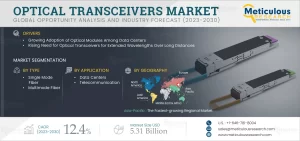The Optical Transceivers Market is expected to reach $5.31 billion by 2030, at a CAGR of 12.4% during the forecast period of 2023 to 2030.
In today’s fast-paced digital world, seamless and high-speed data transmission is essential for industries and consumers alike. Optical transceivers—a critical hardware component for transmitting and receiving data—play a pivotal role in modern networking by offering flexibility in equipment configuration. Since their inception, these transceivers have evolved significantly, ensuring seamless interoperability between various devices and vendors. This blog explores the journey of optical transceivers over the past 25 years and how they continue to revolutionize communication networks.
What Are Optical Transceivers?
An optical transceiver is a hardware device used to send and receive data over fiber optic networks. Unlike early fixed port configurations, optical transceivers allow network operators to customize and upgrade networks without significant downtime. These components ensure smooth interoperation between various systems, with standards defined by bodies such as the Institute of Electrical and Electronics Engineers (IEEE) and Multi-Source Agreements (MSAs) to ensure cross-vendor compatibility.

Download Sample Report Here @ https://www.meticulousresearch.com/download-sample-report/cp_id=5459
The Evolution of Optical Transceivers: A Timeline
The evolution of optical transceivers from the mid-1990s to the present showcases significant technological advancements, each introducing improved data rates, longer transmission distances, and enhanced efficiency. Let’s explore these phases in detail.
1995–2000: The Era of GBIC
- GBIC (Gigabit Interface Converter), launched in 1995, was one of the first hot-swappable transceivers, offering flexibility in network upgrades.
- GBIC allowed users to avoid replacing network equipment for port configuration changes. However, despite its initial popularity, the technology became obsolete with the arrival of smaller, more efficient transceivers.
2001–2005: SFP and XFP Take the Lead
- SFP (Small Form-factor Pluggable) was introduced as a miniaturized successor to GBIC, maintaining the same functionality but with a compact design. SFP supported data rates of 1 Gbps for Ethernet and 4 Gbps for fiber channels, with transmission distances up to 160km.
- XFP (10G Form-factor Pluggable) modules, introduced in 2002, provided 10 Gbps data transmission capabilities, targeting long-distance applications like Dense Wavelength Division Multiplexing (DWDM).
These transceivers laid the foundation for next-generation networking, offering advanced features while supporting various connectors such as LC Duplex, LC Simplex, and RJ45.
2006–2010: SFP+ and QSFP Enable Higher Speeds
- SFP+ (Enhanced SFP), introduced in 2006, further improved data rates to 10 Gbps. It became an industry standard due to its compatibility with leading network equipment vendors and the ability to transmit data over distances of up to 120km.
- The same period saw the rise of QSFP (Quad Small Form-factor Pluggable) transceivers, supporting four data lanes and enabling speeds of up to 40 Gbps. This period also witnessed the introduction of CFP (C Form-factor Pluggable) modules, optimized for 100 Gbps systems.
The industry’s focus during this phase was on scalability, with transceivers becoming a cornerstone of backbone networks powering the internet.
Get Insightful Data On Regions, Market Segments, Customer Landscape, And Top Companies (Charts, Tables, Figures And More) :- https://www.meticulousresearch.com/request-sample-report/cp_id=5459
2011–2015: Enhanced QSFP and CFP2 Innovations
- QSFP+ emerged as a dominant format for 40 Gbps transmission, offering a compact solution for high-bandwidth applications.
- In 2014, QSFP28 was introduced to support 100 Gbps systems, making it the go-to standard for high-speed data centers. At the same time, CFP2 and CFP4 modules enhanced the original CFP design, offering higher performance and reduced physical size. These modules became essential in long-haul systems, achieving transmission distances of up to 2000km.
2016–2021: Compact Transceivers and Ultra-High Data Rates
- The introduction of CSFP (Compact SFP) in 2018 brought further efficiency by halving the number of required ports while reducing power consumption. CSFP modules enabled bidirectional transmission over a single SFP port, optimizing network design.
- QSFP56, launched in 2019, doubled the data rate of QSFP28, achieving transfer speeds of 200 Gbps. This transceiver offered versatility through configurations supporting multi-mode and single-mode fibers.
- QSFP-DD (Quad Small Form-factor Pluggable Double Density), also introduced in 2019, set new benchmarks with data rates of up to 800 Gbps. Its backward compatibility with earlier QSFP standards ensured seamless network upgrades.
- OSFP (Octal Small Form-factor Pluggable) modules introduced 400G and 800G data rates with innovative CS connectors, providing network operators with even greater flexibility.
The latest innovation, SFP-DD, brings double-density transceivers to data centers, offering an affordable, high-performance solution for breakout applications.
Scope of the report:
Optical Transceiver Market, by Form Factor
- QSFP, QSFP+, QSFP-DD, and QSFP28
- SFP, SFP+ and SFP28
- CFP, CFP2, and CFP4
- XFP (10 Gigabit Small Form Factor Pluggable)
- CXP
- SFF (Small Form Factor)
Optical Transceiver Market, by Type
- Single Mode Fiber
- Multimode Fiber
Optical Transceiver Market, by Wavelength
- Long-range
- Extended-range
- Short-range
- Other Wavelengths
Optical Transceiver Market, by Protocol
- Ethernet
- FTTx (Fiber to the x)
- Fiber Channel
- CWDM/DWDM (Coarse Wavelength Division Multiplexing/Dense Wavelength Division Multiplexing)
- Other Protocols
Optical Transceiver Market, Data Rate
- Less than 10 Gbps
- 10 Gbps–40 Gbps
- 41 Gbps–100 Gbps
- More than 100 Gbps
Optical Transceiver Market, by Distance
- Less than 550m
- 551m to 20 km
- 21 Km to 50 km
- 51 Km to 120 km
- More than 120km
Optical Transceiver Market, by Application
- Data Centers
- Data Center Interconnects
- Intra-data Center Connections
- Telecommunication
- Ultra-long-haul Networks
- Long-haul Networks
- Metro Networks
Key Drivers of Optical Transceiver Adoption
- Flexibility and Interoperability: Optical transceivers support seamless integration across multiple vendors, enabling cost-effective upgrades and maintenance.
- Higher Data Rates: The evolution from 1 Gbps to 800 Gbps transceivers reflects the growing demand for higher bandwidth across industries.
- Energy Efficiency: Modern transceivers focus on reducing power consumption, a critical requirement for large-scale data centers.
- Long-Distance Transmission: Transceivers like CFP2 and XFP enable long-haul communication over 2000km, essential for global internet infrastructure.
Immediate Delivery Available | BUY THIS RESEARCH REPORT (Insights, Charts, Tables, Figures and More) – https://www.meticulousresearch.com/Checkout/58591149
The Future of Optical Transceivers: What’s Next?
The demand for high-performance optical transceivers will continue to grow with the increasing adoption of 5G networks, cloud services, and edge computing. Future innovations may focus on improving transceiver density, further reducing power consumption, and supporting even higher data rates. Additionally, AI-driven network management will enable predictive maintenance, ensuring optimal performance for large-scale networks.
Standards bodies like IEEE and MSAs will remain at the forefront of innovation, ensuring transceiver interoperability across devices from different manufacturers. As industries move toward network virtualization and software-defined networking (SDN), optical transceivers will remain critical for supporting these transformations.
Contact:
Meticulous Market Research Pvt. Ltd.
1267 Willis St, Ste 200 Redding,California, 96001, U.S.
USA: +1-646-781-8004
Europe: +44-203-868-8738
APAC: +91 744-7780008
Email– sales@meticulousresearch.com
Visit Our Website: https://www.meticulousresearch.com/
Connect with us on LinkedIn- https://www.linkedin.com/company/meticulous-research
Meticulousblog.org | Top Market Research Reports Blog – https://meticulousblog.org/






